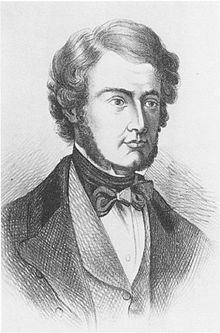 | ||
Institutions Medical College and Hospital, Kolkata Notable prizes Fellow of the Royal Society | ||
William Brooke O'Shaughnessy MD FRS (October 1809, Limerick, Ireland – 10 January 1889, Southsea, England) was an Irish physician famous for his work in pharmacology and inventions related to telegraphy. His medical research led to the development of intravenous therapy and introduced the therapeutic use of Cannabis sativa to Western medicine.
Contents
Early life
O'Shaughnessy studied forensic toxicology and chemistry in Scotland, and graduated in 1829 with an MD from the University of Edinburgh Medical School. In 1831, at the age of 22, as a result of his analysis of the blood of cholera victims, O'Shaughnessy laid the foundation for what was to become intravenous fluid and electrolyte-replacement therapy in the treatment of cholera. Thomas Latta of Leith was later to become the first to use intravenous therapy based on O'Shaughnessy's research.
O'Shaughnessy joined the British East India Company in 1833 and moved to Calcutta, remaining in India for approximately nine years where he fulfilled the roles of surgeon, physician, professor of chemistry at Medical College and Hospital, Kolkata, and scientist.
Work in India
His first stint in India was marked by work in the subjects of botanical pharmacology, chemistry, galvanic electricity, and underwater conduction, among others. At Calcutta, he was a member of the Medical and Physical Society of Calcutta, where he published one of his first papers on medical applications of cannabis. He validated folk uses of cannabis in India, discovered new applications, and ultimately recommended cannabis for a great variety of therapeutic purposes. O’ Shaughnessy established his reputation by successfully relieving the pain of rheumatism and stilling the convulsions of an infant with cannabis. He eventually popularized its use back in England. His most famous success came when he quelled the wrenching muscle spasm of tetanus and rabies with resin. While he could not cure tetanus, he did observe that the cannabis mixture reduced their symptoms of spasticity and their suffering. In 1841, he returned to England where he introduced cannabis indica to Western medicine and continued his scientific writings. He was a member of the London Electrical Society and was elected a fellow of the Royal Society in 1843.
Return to India
In 1844, O'Shaughnessy returned to India where he worked in various government positions in the fields of pharmacology and assay. During this period he began work on various telegraph instruments and systems. After briefly returning to England in 1852, O'Shaughnessy was appointed Superintendent of Telegraphs in 1853. During the years 1853-5 he installed 3500 miles of telegraph across India and wrote numerous manuals and reports on his telegraph inventions.
Knighthood and return to England
In 1856 he was knighted by Queen Victoria for his work on the telegraph in India. He was also appointed Director-General of Telegraphs at this time. During the following years O'Shaughnessy wrote on telegraphy-related subjects, including a book of Private Codes for encrypted telegraphy. In 1860, O'Shaughnessy returned to Europe for sick leave where he remained in obscurity until his death in January, 1889.
He adopted the surname Brooke on the death of a relative.
